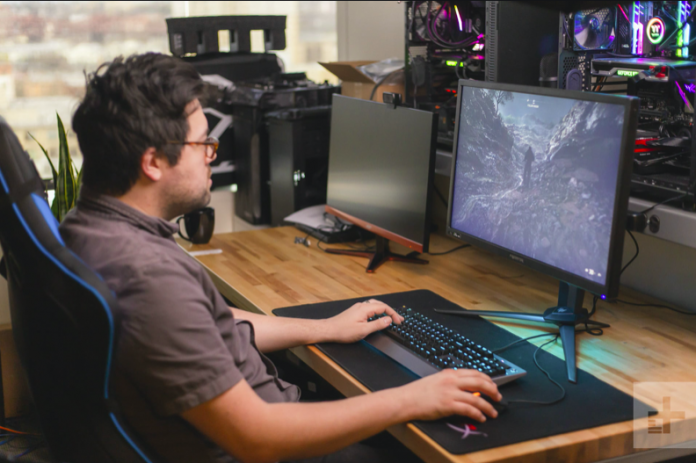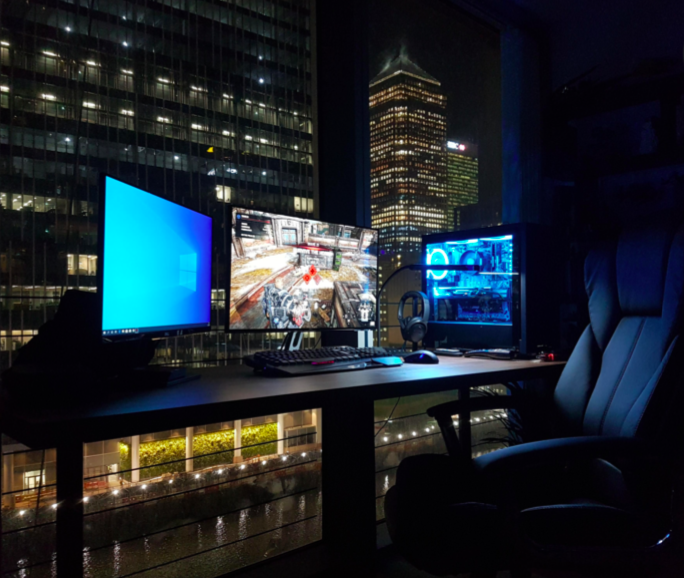
In the 21st century, gaming on PC has different kinds of vibes and adrenaline rush to it. The reason being, today’s games are not only about catching a snake’s next bug hunt using the same four buttons. Instead, multiple player games have so many technical settings, including Vsync? You may wonder, what is vsync? Should it be turned off? Or am I doing something wrong? Well! To be honest, Vsync can be helpful in both cases. How? You will find out in this reading.

Today, we present a beginners guide on Vsync. You will find out how to enable or disable Vsync. And what are the best possibilities and conditions where it must be turned on and off? But, before we go ahead and count down brief instructions on the same, let’s take a glimpse of the introduction – What is Vsync?
What is Vsync?
Table of Contents
To begin with, Vsync is an abbreviated term for “Vertical Synchronization.” This feature is basically available on high-end PCs with real-time, potentially high rated processors. In simple words, the Vsync feature is made for laptops that are used by professionals and gamers. For example, video editors and photoshop users use high-end intel processor computer systems. In these systems, vertical synchronization is a feature that allows the processor to read the display or graphics current rate and synchronizes this rate to an improvised one. Henceforth, helping to improve the scalability of graphics appearing on screen.

Gamers find this feature quite beneficial when their screen or gaming graphics start to act up or tear amid the game. Without a doubt, Vertical synchronization helps to enhance the speed and responsiveness of the game in every way possible.
For the most part, vertical sync graphics technology doesn’t only create an effect on the frame rate of graphics. Instead, it helps to root a balance between the current frame rate of graphics to that of the refresh rate of PC display or monitor. It is one of the reasons why 3D Games run so smoothly on your screen.
Thus, we have shortlisted the following factors where Vertical synchronization is quite helpful and react powerfully when turned ON:
-
Screen Tearing
A condition where one part of the screen is entirely frozen, and another is running. It causes a “fluttering effect”, which is both worse to visual and listens to.
-
Stuttering Sound
When sound entirely goes away or creates a stuttering effect.
-
Brightness level
More often than not, games in today’s range come with HDR quality features. But, if your display is old and unsupportive, vsync helps to push it to a balancing rate.
Alongside the above-mentioned main issues, vertical synchronization is quite a helpful feature, as spoken by HP Experts. You can rely on it for the best gaming experience as it enhances colours, graphics, freedom to move with stutter and more.
What are the different types of Vsync?
To begin with, Vsync pushes the FPS limit. FPS stands for framerate or Frame per second. According to the latest studies, gamers only require 30 frames per second for an average experience. On the other hand, the utmost frame rate that gamers can opt for games like GTA, Minecraft, and CSGO can be 60 frames per second.

Sometimes, the Frame rate can also go above and beyond 60 frame rates per second, depending on what type of vsync you have. Most passionate gamers also purchase particular PCs that come with any of the following qualities. Let’s find out what are those types:
Type 1: Adaptive Vsync – What is Vsync?
Created by NVIDIA, Adaptive Vsync is highly compatible with gamers who have GT-600 series graphic cards installed on their PC. In many cases, Vsync has huge potential to refresh the frame rate to more than 60 per second. Yet, their display rate remains smaller. In this case, Adaptive-Sync limits its output and finally helps the game to begin at a smooth level. It is an alternative technology if you don’t have “vsync” feature on your PC already.
Type 2: Smooth Vsync
More often than not, users complain about how fast their graphics are, yet, frame rate consistently creates barriers like stuttering and screen tearing. Hence, GPU has designed Smooth Vsync as an all-time alternative to basic vsync technology. By creating a balance between its output limit and scalable link interface, it allows the graphics to run at a smooth frame rate.
Please note that a smooth frame rate is much-much better than having the highest frame rate, which doesn’t balance with your PC’s potential at all.

Type 3: Enhanced Sync – What is Vsync?
Created by AMD graphic cards designer corporation, Enhanced Sync is a type of additional synchronization technology that ensures the capability of Vsync features already existing on your PC. it doesn’t release a higher frame rate first handedly. Instead, it acts as a balancing technology between Vsync and Display rate. In simple words, it ensures that Vsync and display rate are running parallel to each other.
Type 4: Fast Sync
Above all, Fast Sync is one of the preferable vertical synchronization technologies among gamers. To the reader’s surprise, it remains compatible with the GT 900X series or higher only. The most loved key feature of Fast Sync is that it deducts the latency of graphics by 2X times. Henceforth, if you are a gamer who often shoots in-game and hears the gunshot after 20 seconds or so, Fast Sync is a “made for you” tech.
With that being said, you must recollect your hope. Because, in the event that your screen tears or stutters many times during the game, Vsync is one option to turn to. Now, let’s see should or should not turn Vsync OFF.
Which is better – Vertical sync OFF or ON?
For those users who think by turning off Vsync, your Frame Rate will drop down to zero. Believe me. It is not going to happen. The only con of “turned off” Vsync is that it will no longer push your FBS limit. Now, there are many conditions when it is best to turn on or off Vsync. Here’s a glimpse of those conditions:
Graphically Intense Climax: This condition is very common. Let’s suppose you are playing GTA or PUBG on your PC. Now, you are at the edge of winning or losing. In the middle of this climax, if your frame rate drops, Vsync will increase the output. Henceforth, causing your screen to flutter for nanoseconds. Yet, it can leave you confused, and you won’t know your next move. At last, you lose.
Thus, we advise gamers to turn off Vsync when they are on the verge of the game.

The game’s frame rate required is higher than the monitor’s refresh rate: This condition is again very common. According to the latest research, the average refresh rate of monitors is 60Hz. On the other hand, processors released in 2021 have refresh rates as high as 240 Hz. Also, Game applications or consoles’ higher frame rate requirements can be 240 FBS. Now, let’s suppose your monitor’s maximum refresh rate is 120 Hz only. In comparison, your game’s framerate requirement is 240 FBs. In this case, you will require Vsync to balance both rates out.
Thus, there’s no particular answer to whether you should keep Vsync turned off or on? So, if you are reflecting on how to turn it on or off, check out the guide given below:
How to turn Vertical sync ON?
To begin with, it is very easy and basic to enable vertical synchronization. All you need to do is enter the Nvidia control panel and set up settings based on your requirements.
Check out the following instructions, to begin with, the process:
- Go to the “Start Menu.” Or, tap on “Windows Key.”
- In the search bar, “NVIDIA Control Panel.”
- Under the best match result, tap on the “NVIDIA Control Panel” Option.
- Further, click on the “Manage 3D Settings” option.
- Now, scroll down to the “Vertical Sync or Vsync” option.
- After you click on it, you will see the option to “Force ON/OFF” Vsync.
- Tap on “Force ON” to enable it.
Once you turn Vsync ON, save the settings and go back. It is best to restart the game for the best experience.

In the second condition, if you are at the climax, you can turn off or force stop vsync.
How to disable Vsync?
Again it is very straightforward to disable vertical synchronization if it is causing issues. All you need to do is enter the Nvidia control panel and set up settings based on your requirements.
Check out the following instructions, to begin with the process:
- Go to the “Start Menu.” Or, tap on “Windows Key.”
- In the search bar, “NVIDIA Control Panel.”
- Under the best match result, tap on the “NVIDIA Control Panel” Option.
- Further, click on the “Manage 3D Settings” option.
- Now, scroll down to the “Vertical Sync or Vsync” option.
- After you click on it, you will see the option to “Force ON/OFF” vertical sync.
- Tap on “Force OFF” to disable it.
Please note that it is best to Force Stop Vsync when you are on the verge of dying in the game. Because when Vsync increases or decreases frame rate based on the monitor’s refreshing rate, it will wait for the next screen to appear. Therefore, you will have to hold back for it, which makes you think that your PC is hanging or slowing down.
Epilogue
Now that “what is Vsync” has become a clear concept to you! Please ensure that you are not at the disadvantage of increasing output lag while vertical sync is ON. For more insights, get in touch with us. Bookmark us for upcoming tricks to resolve vertical synchronization errors. Until then, Goodluck!















